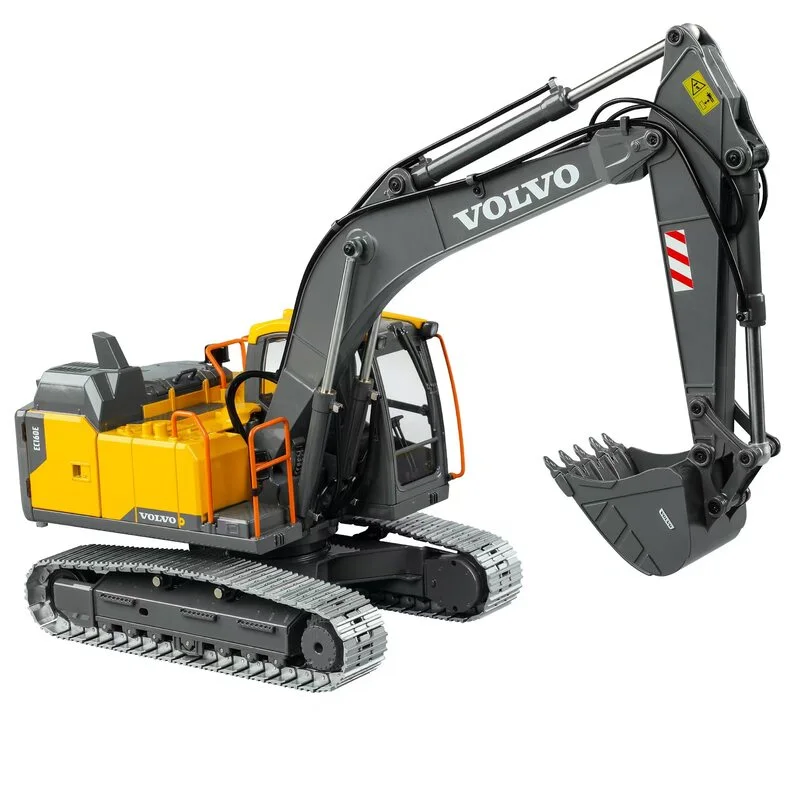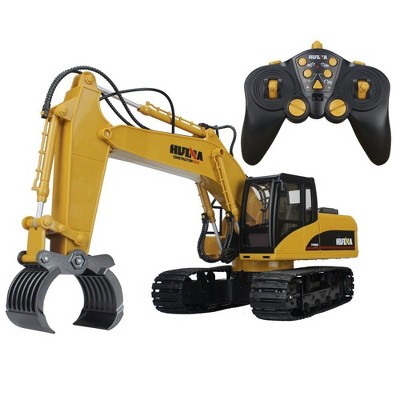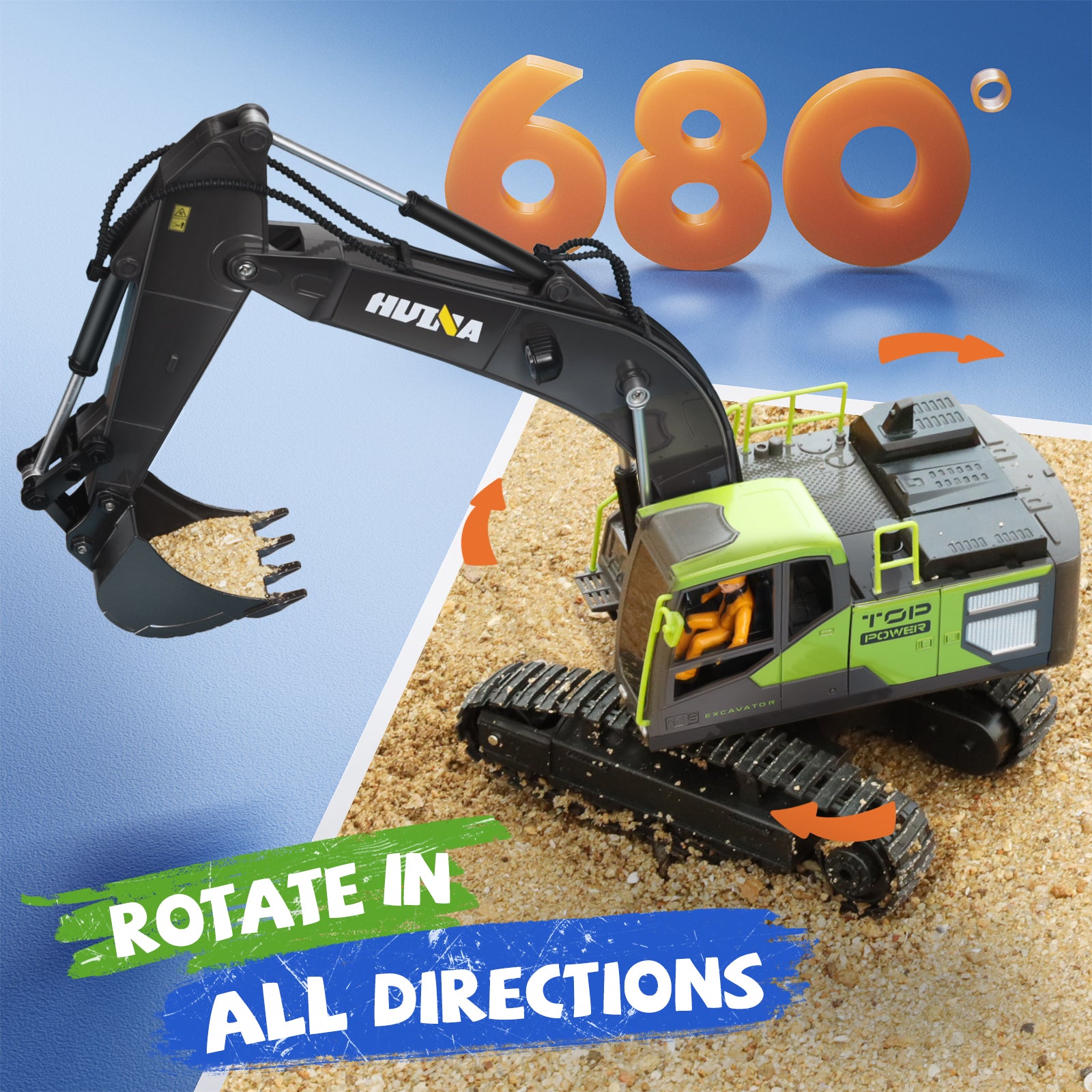The Future of Excavation: Why a rc excavator is Here to Stay
Wiki Article
The Crucial Attributes of Excavator That Make It a Must-Have Device
Excavators are essential in the building and landscape design markets. Their flexible add-ons enable a series of jobs, from digging to demolition. Furthermore, they boast superior excavating deepness and reach, powered by robust engines. Driver convenience and compact styles improve usability in various environments. What genuinely sets excavators apart are their sophisticated hydraulic systems and longevity. Recognizing these functions can clarify why they are taken into consideration crucial devices on any task website.Versatile Attachments for Boosted Functionality
Although excavators are effective makers by themselves, the addition of functional attachments greatly boosts their functionality. These accessories change a standard excavator right into a multi-purpose device, suitable for a range of tasks. Buckets, as an example, come in numerous forms and sizes, enabling drivers to dig, scoop, and relocate materials efficiently. Hydraulic thumbs can be included for improved gripping and handling of cumbersome items, such as logs or rocks.Furthermore, specialized attachments like augers and breakers permit exploration and demolition job, increasing the excavator's energy on construction sites. remote control excavator. Grapples are one more option, perfect for arranging and moving debris. This versatility not only enhances efficiency yet additionally decreases the demand for numerous machines, saving time and prices. By outfitting excavators with the right attachments, drivers can take on diverse projects, making them crucial in the building and construction industrySuperior Excavating Deepness and Get To
Excavators are designed with superior excavating depth and reach, permitting them to maneuver in limited spaces and accessibility hard-to-reach areas. This capacity is essential for numerous construction and excavation tasks, where standard equipment might drop brief. With adjustable boom arms and extendable tracks, excavators can easily browse unequal surface while keeping stability.The digging depth can differ considerably amongst designs, often ranging from 10 to 25 feet, depending on the design and objective. This function allows drivers to excavate structures, trenches, and other deep structures effectively. Additionally, the reach of an excavator permits specific excavating and product handling without repositioning the maker frequently, conserving time and labor costs.Ultimately, the premium excavating deepness and reach of excavators make them vital for experts seeking to complete complicated tasks with precision and efficiency. Their adaptability enhances efficiency on task websites, showcasing them as a necessary device in modern construction.Powerful Engine Efficiency

When it concerns effectiveness and performance on construction sites, powerful engine efficiency plays a crucial duty in the capacities of an excavator. A durable engine creates substantial horse power, allowing the machine to deal with sturdy jobs with simplicity - remote control excavator. This stamina translates into faster cycle times, allowing operators to full tasks much more quickly.Additionally, powerful engines provide the essential torque to take care of difficult terrains and differed loads, making sure that the excavator can carry out successfully under various problems. Whether it is raising, digging, or moving materials, the engine's efficiency straight impacts the overall operational efficiency of the machine.Furthermore, advancements in engine modern technology have caused boosted gas effectiveness, lowering functional costs while preserving power output. Inevitably, the engine's performance functions as the backbone of an excavator, verifying its condition as an essential tool in the construction industry
Advanced Hydraulic Solutions

Boosted Raising Capacity
A substantial improvement in lifting ability can be credited to innovative hydraulic systems discovered in contemporary excavators. These systems make use of high-pressure fluid to create better force, enabling operators to lift heavier lots with convenience. The engineering behind these hydraulics guarantees peak efficiency, providing an excellent power-to-weight proportion that enhances general effectiveness. Consequently, excavators can take on requiring tasks, such as raising big materials or tools, without jeopardizing stability. Additionally, the durable design of hydraulic elements contributes to enhanced durability and reliability, making them ideal for different construction atmospheres. This boosted training capability not only reduces the time needed for projects but likewise minimizes the requirement for extra equipment, showing essential for both productivity and cost-effectiveness in the construction industry.Boosted Precision Control
Conventional excavators usually struggled with precision, modern hydraulic systems have transformed control devices, enabling drivers to implement jobs with exceptional accuracy. These innovative systems use symmetrical control shutoffs that enable smoother and much more receptive activities, substantially reducing the margin for error. Operators can now finely tune the excavator's motions, making it much easier to navigate limited spaces and deal with delicate products. Enhanced feedback systems even more inform drivers of real-time performance, making certain excellent sychronisation in between the equipment and operator. This raised accuracy not just boosts efficiency but likewise improves safety on job websites, reducing the danger of crashes. Because of this, modern excavators geared up with advanced hydraulic systems are vital tools for building and excavation projects calling for precise precision.Operator Comfort and Presence
Operator comfort and presence are critical parts in the style of modern excavators (remote control excavator). Attributes such as ergonomic seat style, improved presence options, and effective control designs substantially improve the operator's experience and efficiency. Prioritizing these elements warranties that drivers can work successfully and securely in various conditionsErgonomic Seat Style
Convenience and exposure are vital in excavator style, with the ergonomic seat playing a necessary role in improving the driver's experience. An ergonomic seat is crafted to sustain the operator's body, minimizing tiredness during lengthy hours of procedure. Flexible functions, such as seat height, backrest angle, and back support, accommodate private preferences and advertise ideal pose. These modifications improve comfort and allow the operator to maintain concentrate on tasks without discomfort. In addition, a well-designed seat can give much better side assistance, enabling smoother maneuvering when the excavator is in operation. This thoughtful layout not just enhances efficiency but also adds to general safety and security, making certain that operators can execute their responsibilities successfully and effectively.Enhanced Presence Attributes
The design of an excavator over here expands beyond just the seat, with enhanced visibility features playing a significant role in operator comfort and overall safety. Big windows and purposefully located mirrors supply operators with a clear view of their environments, minimizing blind places. This design consideration permits far better spatial recognition, which is essential in busy work environments. Furthermore, many excavators include rearview cameras and advanced monitoring systems that assist drivers in maneuvering limited areas. The combination of these visibility includes not just advertises security but also reduces driver tiredness by enabling easier monitoring of job areas. Ultimately, boosted presence adds to extra efficient operations and assists assure that excavators can execute their jobs effectively and securely.Control Design Effectiveness
While maneuvering complex job websites, a reliable control design substantially improves both operator convenience and visibility. A well-designed control setup assurances that operators can access crucial functions with marginal initiative, lowering exhaustion during long hours. Ergonomic joystick placements and intuitive switch plans permit seamless operation, allowing operators to keep concentrate on the task at hand. Furthermore, clear visibility of both the workspace and the control board is essential for safety and security and accuracy. Modern excavators frequently include flexible seats and control settings to fit different operator choices, better enhancing convenience. Eventually, an attentively made control design not only improves performance but additionally fosters a safer working atmosphere by enabling operators to react quickly to changing conditions.Compact Layout for Urban Environments
As metropolitan construction sites frequently face room restrictions, a small style ends up being important for excavators operating in these settings. These equipments are engineered to browse limited spaces, enabling for effective ability to move in jampacked job websites. A reduced impact enables them to function very closely to existing frameworks, lessening disturbance and making best use of productivity.The small layout commonly consists of shorter tracks and a tighter turning span, promoting procedure in narrow streets and restricted locations. Light-weight materials contribute to ease of transport, making it less complex to relocate the excavator from one place to another within the city landscape.Additionally, many portable excavators are furnished with features such as extendable arms and functional add-ons, enhancing their performance while keeping a little dimension. This flexibility allows drivers to deal with a variety of tasks, from excavating to demolition, all while fitting flawlessly right into the restrictions of metropolitan atmospheres.
Resilience and Upkeep Considerations
Sturdiness stands as a vital consider the efficiency and longevity of excavators, especially sought after urban settings. These devices are subjected to extensive conditions, including differing dirt types, severe temperature levels, and high-frequency use. High-quality products and durable construction are necessary for ensuring that excavators can stand up to these difficulties without endangering functionality.Regular maintenance is equally vital in protecting durability. Scheduled inspections, timely oil adjustments, and the replacement of worn components add substantially to an excavator's life-span. Operators should also take notice of hydraulic systems, tracks, and undercarriages, as these components commonly bear the burden of wear and tear.Investing in resilient excavators with substantial upkeep plans enhances dependability and decreases downtime, ultimately bring about boosted performance on construction sites. Understanding the interplay between toughness and maintenance is essential for anybody considering the purchase of an excavator for city jobs.Frequently Asked Inquiries
Exactly How Do Excavators Contrast to Various Other Building Devices?
Excavators stand out amongst construction equipment due to their flexibility, enabling jobs such as digging, training, and grading. Compared to others, their hydraulic abilities provide greater effectiveness and power, making them essential on numerous task sites.What Security Features Are Consisted Of in Modern Excavators?
Modern excavators incorporate various safety features, consisting of rollover protection systems, alarms, and progressed visibility enhancements. These aspects collaborate to reduce dangers, making certain operator security while boosting effectiveness on building sites and other demanding environments.
Can Excavators Be Made Use Of in Wintertime Conditions?
Excavators can certainly be made use of in winter conditions, supplied they are outfitted with appropriate winter months accessories and preventative measures are taken. Proper maintenance and changes boost their performance, guaranteeing effective operation despite challenging weather circumstances.What Is the Average Lifespan of an Excavator?
The ordinary life expectancy of an excavator commonly varies from 7,000 to 10,000 hours of operation. This period can significantly depend upon upkeep techniques, running conditions, and the particular model's resilience and design functions.Exactly how Do I Choose the Right Excavator Dimension for My Project?
Selecting the best excavator size includes examining project scope, website problems, and product types. Think about variables like reach, deepness needs, and weight capacity to guarantee optimal effectiveness and security during operation. Dimension matters considerably in job success. Furthermore, the reach of an excavator allows for accurate digging and product handling without repositioning the equipment regularly, saving time and labor costs.Ultimately, the exceptional excavating depth and reach of excavators make them indispensable for professionals seeking to finish check this site out intricate jobs with accuracy and efficiency. Convenience and presence are paramount in excavator design, with the ergonomic seat playing a crucial duty in boosting helpful site the driver's experience. The layout of an excavator extends beyond just the seat, with improved visibility features playing a considerable role in operator comfort and total safety and security. Modern excavators frequently include flexible seating and control setups to accommodate different driver choices, even more boosting convenience. Light-weight materials contribute to reduce of transportation, making it easier to move the excavator from one location to an additional within the metropolitan landscape.Additionally, many portable excavators are outfitted with functions such as functional accessories and extendable arms, enhancing their functionality while keeping a small dimension.Report this wiki page